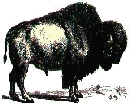HISTORY OF GRAZING ON PUBLIC LANDS
Since the country' earliest days, Congress recognized the public lands as a national
asset. As the nation acquired new territory through treaty, purchase, or conquest
(see below), Congress directed that it be made available in order to promote settlement of
the West. Much of the original 1.8 billion acres of the public domain was given or
sold to individuals, corporations, and states. However, in the late 19th century,
Congress began to redirect Federal land policy as lawmakers recognized the importance of
retaining certain lands in public ownership. During this time, the first National
Forests, National Parks, and National Wildlife Refuges were designated. During the western migration of the mid and late 1800s, rangelands attracted settlers who wanted to build a new life of ranching, farming, business, and mining. As settlement continued, competition for land and water intensified. Land was put to uses that were not sustainable over the long term, and insufficient thought was given to future needs. In the 1930's, when overgrazing threatened to reduce Western rangelands to a dust bowl, Congress approved the Taylor Grazing Act (TGA) of 1934, which for the first time regulated grazing on the public lands through the use of permits. The Taylor Grazing Act provided a way to regulate the occupancy and use of the public land, preserve the land from destruction or unnecessary injury, and provide for orderly use, improvement, and development. In 1964, Congress established the Public Land Law Review Commission to make recommendations on how the public lands should be managed. Congress responded to the Commission's report by enacting the Federal Land Policy and Management Act (FLPMA) in 1976. Utah The BLM Today
RECENT HISTORY Introduction In 1991, the BLM Director asked the National Public Lands Advisory Council to recommend how BLM could improve rangeland management. A "Blue Ribbon Panel" of the Council cited a need for developing goals and objectives that sustain natural systems while providing for human needs and desires. The panel recommended that BLM develop rangeland program goals and objectives based on modern ecological concepts to ensure protection of the basic resources (soil, water and vegetation) and the sustainability of the rangeland systems. Using the 1992 Blue Ribbon Panel Report and concerns raised by both industry and conservation groups as starting points, BLM initiated a review and analysis of livestock grazing management on public lands. New Regulations In the spring of 1994, BLM published proposed changes to the grazing regulations and a draft Environmental Impact Statement (EIS). To encourage public comment, BLM and the Forest Service held 48 "open houses" and hearings throughout the West on the proposed rule and draft EIS. More than 1900 people testified at these hearings. In addition to considering testimony from these formal hearings, BLM received and considered more than 20,000 additional comments from over 11,000 people on the proposed rulemaking and its accompanying analysis. The final grazing regulations were published February 22, 1995. In response to a request from several western Senators, implementation was delayed until August 21, 1995. The final regulations were substantially modified based upon public comment. The most notable change was to drop the grazing fee proposal. BLM has administered public land grazing under the new regulations since August 21, 1995. In addition, 24 newly formed citizen Resource Advisory Councils helped BLM to develop standards of rangeland health and guidelines for grazing management. These Resource Advisory Councils, who meet regularly, are of a diverse and balanced composition to represent the full spectrum of multiple uses and operate in a cooperative and collaborative manner. The role of the Resource Advisory Council (RAC) is to provide advise and local perspectives to the BLM. Members must reside in the State of their jurisdiction. The BLM is very grateful to the many RAC members, permittees, leasees and interested members of the public who devote many hours to maintaining and improving the health of the public rangelands.
Accessions to the Public Domain
From Public Land System of the U.S., Historical
Outline by S.V. Proudfit, GPO 1924 Other interesting sites: |



